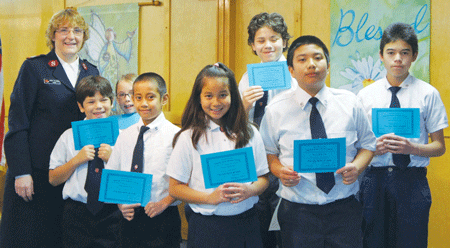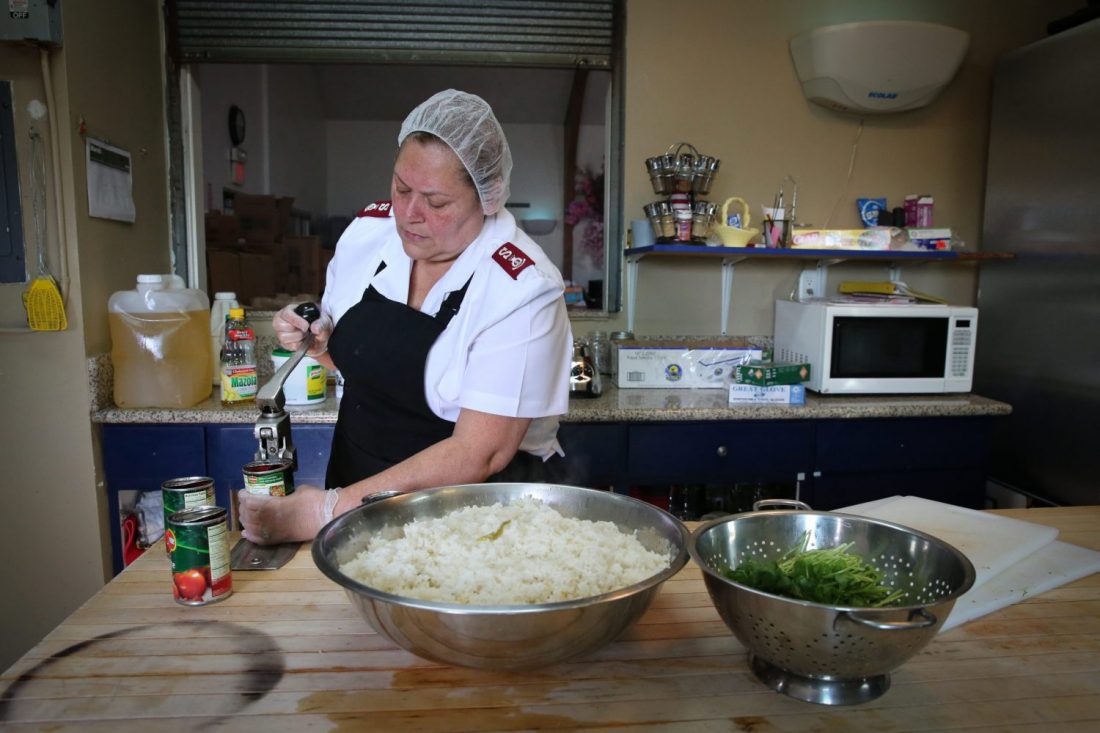BY DAWN MARKS –

There’s a saying within the ARC Command that the acronym A.R.C. also means “Always Ready for Change!” Changes at the ARC continue to be most evident in the program beneficiaries who make new commitments that change their lives in remarkable ways.
The widespread use of technology in ARC operations is another change at the ARC. Ultimately, the new technologies allow the ARCs to help more men and women and save more souls.
There are 25 ARC locations in the Western Territory. Centers are located in six states: California, Oregon, Washington, Colorado, Arizona and Hawaii, with the majority (18 centers) in California. There are 2,289 beds for men and 135 beds for women in the territory with the addition of a 28-bed, brand new women’s residence facility in Anaheim, which will open this June.
Six other women’s ARC facilities are located in Denver, Phoenix, San Diego, San Francisco, Fresno and Pasadena. The Oakcrest Women’s Residence (Pasadena ARC), opened in June of last year. Plans to open a new ARC women’s residence in Seattle are currently in progress.
The purpose of The Salvation Army ARC program is the rehabilitation and salvation of physically, emotionally, spiritually and socially handicapped men and women. They come for assistance either voluntarily or by court order. Most have a long history of drug and/or alcohol addicions. The goal of the ARC program is to help individuals regain their sense of self-worth and return to society to live productive lives.
Program participants, called “beneficiaries,” live in the ARC residence for six months while they complete their prescribed rehabilitation program. Beneficiaries participate in work therapy assignments which allow them opportunities to learn and practice four main skills: structure and self-discipline, self-respect, accepting responsibility, and working with others.
SELF-SUPPORTING

Last year 7,500 ARC beneficiaries were admitted in the Western Territory. Of the 7,500 admitted, 30% successfully completed the prescribed rehabilitation program requirements. The program requires participation in Alcoholics Anonymous/Narcotics Anonymous meetings, individual and group counseling, successful completion of a work therapy assignment, and mandatory attendance at Sunday and Wednesday chapel services.
Many centers also offer supplementary courses such as literacy, GED and parenting skills classes. The ARC Command (ARCC) annually evaluates each center in the area of program using its own stringent accreditation standards. Centers are also evaluated annually by ARCC in the areas of retail and production.
Today’s modern ARCs utilize advanced technologies in donation pick-up scheduling, truck routing, production, retail and program. These changes have increased operational efficiencies and assist centers in providing better service to donors and customers. There are over 1,600 computers in use throughout the territory, which are directly supported by the Information Technology Group at ARCC.
CALL CENTER FOR DONATIONS
All ARC donation calls in the territory are routed through the 1-800-95-TRUCK phone number to a state-of-the-art call center located at territorial headquarters in Long Beach, CA. The call center employs 85 people who work as donor service representatives for the 25 centers in the territory. The call center handles all types of donation calls, including vehicles. The donor information is input into the Donor Service System (DSS). The system provides the next available pick-up date and gives scheduled donors an estimated time for their truck’s arrival. Truck routing information is also provided by DSS.
An average of 80,000 100,000 donation pick-ups are scheduled at the call center each month. Last year they scheduled over 1 million donation pick-ups for the 25 centers. Soon, donors will also have the option of scheduling their own donation pick-ups through the internet.
New uses in technology are helping the local centers. Most ARCs have implemented a new software program called BITS (Beneficiary Information Tracking System). The new BITS program enables centers to track beneficiaries throughout the 25 ARCs through a centralized client data base. Once a data base of names has been established over a period of time, centers will be able to know if a beneficiary has ever been enrolled in the past at another ARC in the Western Territory. BITS also helps centers to more effectively assign and track beneficiary work therapy assignments.
DONATION PROCESSING
First time visitors to an ARC are impressed by the efficiency and organization of ARC donation processing facilities. Donations are sorted by department, inventoried, and repaired when possible. “In Today Out Tomorrow” refers to the ARC goal to process all incoming donations the same day so that they can be shipped out to the thrift stores the following day. New windows-based touch screen computers have replaced the old Alpha Micro computer systems in most ARC warehouses. The new touch screen computers are more reliable and user friendly. The biggest advantage of this new system is less “down time” in production since each station now runs independently.
Centers process (hang, tag and prepare for shipping) between 6,000 to 12,000 clothing garments and 175- 420 totes of bric-a-brac items every day. The role of the ARC as a major recycling entity in the community continues to increase every year. Last year, roughly 41,000 tons of clothing were recycled through the 25 ARCs in the Western Territory.
The ARCs display checklists of recalled items from the U.S. Consumer Product Safely Commission in their warehouses in an effort to try to prevent such items from being sold. There are other items that ARCs are unable to process due to expensive landfill costs, environmental concerns, or their inability to make the necessary repairs. Donated items that could not be recycled cost the Western Territory ARCs $2.1 million dollars last year in dump fees. It is a continual challenge for the ARC to find ways to effectively minimize this expense.
GROWING NUMBER OF STORES
Eight new ARC thrift stores were opened in new markets in the Western Territory last year. Six additional stores were moved to better locations in existing markets and six other stores were remodeled. Installation of new windows-based software on all POS store registers is currently in progress. The new registers will help with improved sales monitoring, better customer and employee tracking and loss prevention.
Additionally, recent investments in advertising and new marketing materials have helped centers to market their programs, donation services and thrift stores.
“The most important area of the ARC is people: beneficiaries who come for help, officers who provide leadership and God’s redemptive message, employees who faithfully serve, volunteers who give of themselves, and many others,” said Lt. Colonel Dan Starrett, ARC commander.
Developed just four years ago, ARC corps are a relatively new addition to the ARC ministry in the West. ARC corps provide program graduates, their family members, and others from the recovering community, opportunities for Christian development within The Salvation Army corps community.
“One leaves an ARC corps excited and blessed,” said Major Betty Gibson, ARCC corps development director. “The music is motivating and the preaching is powerful. Men and women who have been freed from the bondage of drugs and alcohol give powerful testimonies to God’s grace in their lives.”
The first ARC corps in the Western Territory started at the Canoga Park ARC in 1997. Three other ARC corps have since been opened in Denver, Carpinteria and Anaheim. Some beneficiaries attend meetings at their ARC corps or local corps community centers, in addition to the mandatory chapel services at the ARC.
There are currently 77 soldiers, 80 adherents and three junior soldiers in the four ARC Corps in the West.
“This year we anticipate even greater victories and pray that God will provide the increase in membership and blessings,” said Gibson.












